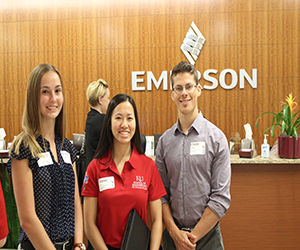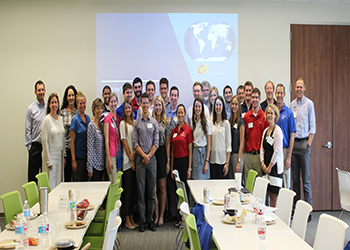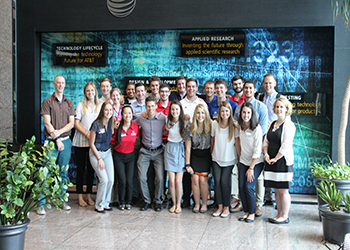SELF on the Road 2016 - Day 3 (Austin)
After an early breakfast, SELF was on the road to Emerson Electric. A large company with a diverse portfolio, we met primarily with the Process Management division who work to deliver technical solutions and support for complex industrial processes.

We first saw the executive presentation suite, which briefs clients or potential clients on the services Emerson provides and we learned more about the company philosophy and their embrace of innovations that will advance their industry far into the future. Next, we met with a selection of employees who discussed their career paths in two sessions: phase one of your career (years 1-5), and phase two (years 6-10). Certainly, no two paths were alike, and all our hosts impressed upon us the importance of being willing to learn and striving to do your best in any role.
After the break out sessions, we had the opportunity to meet with Claudio Fayad, the Vice President of Software Development. Growing up in an agrarian community in Brazil, Mr. Fayad became determined to be on the forefront of technological change, to create the products that would change the world. Through his education as an engineer and matriculation into an MBA, Mr. Fayad came to understand that innovation does just happen with a good idea, it requires good management and leadership, and the types of leaders that he hopes we will be for the world. After his presentation, we were treated to a buffet lunch and had the opportunity to speak more with the presenters we met that day.

After our visit at Emerson we headed over to Square Root. It is easy to see why Square Root has been named amongst Fortune Magazine’s best small companies to work for. The company's offices are located in five houses near downtown Austin, and everyone including the founder and CEO, Chris Taylor, stressed the importance of their company culture.
Square Root was founded by Chris in 2006 and he told us all about his path that had lead him to starting his own business. Some of the areas he mentioned that are important to focus on were founding, frugality, and focus. He pointed out that you should found your company whenever you can because no time is going to be perfect. Frugality is important. Especially in those early years when the company is just getting on its feet. The last area he mentioned was focus. According to Chris, it is incredibly important to focus your business on one thing that you are really good at.
One of the most impressive elements of Square Root is that it was bootstrapped. That means that there was not outside capital used to keep Square Root afloat or help it grow. According to Chris, Bootstrapping has more control than starting a business with venture capital. On the other hand with venture capital the business can move faster.
After Chris presented to us we were able to mingle and ask questions with him and other employees of Square Root. The visit was definitely a success, it was inspiring to get to learn more about such a successful startup.
Lastly, the SELF Fellows had the opportunity to visit with Greg Edwards at AT&T’s Human Factors Lab. During the visit, Fellows learned about leveraging human data and preferences with design decisions to maximize the user experience. For example, in developing the user interface for their U-verse TV platform, Mr. Edwards visited with users of AT&T's existing services as well as the services of their competitors. Through these visits, the lab was able to collect data that helped produce a better, more usable interface.

During the visit, Hunter Senior had an opportunity to participate in a mock study and demonstrate how they collect data at the Human Factors Lab. Mr. Senior said “As an Architectural Engineering student, I wasn’t sure how this tour would apply to me, but it really reinforced the need to keep human function and design in mind throughout my career to be the best engineer I can be.”
Also called User Experience Engineering, the Human Factors laboratory offered a peek at yet another different path to take an engineering degree. The tour of this facility was an excellent way to end a day of wide-ranging tours all over Austin.